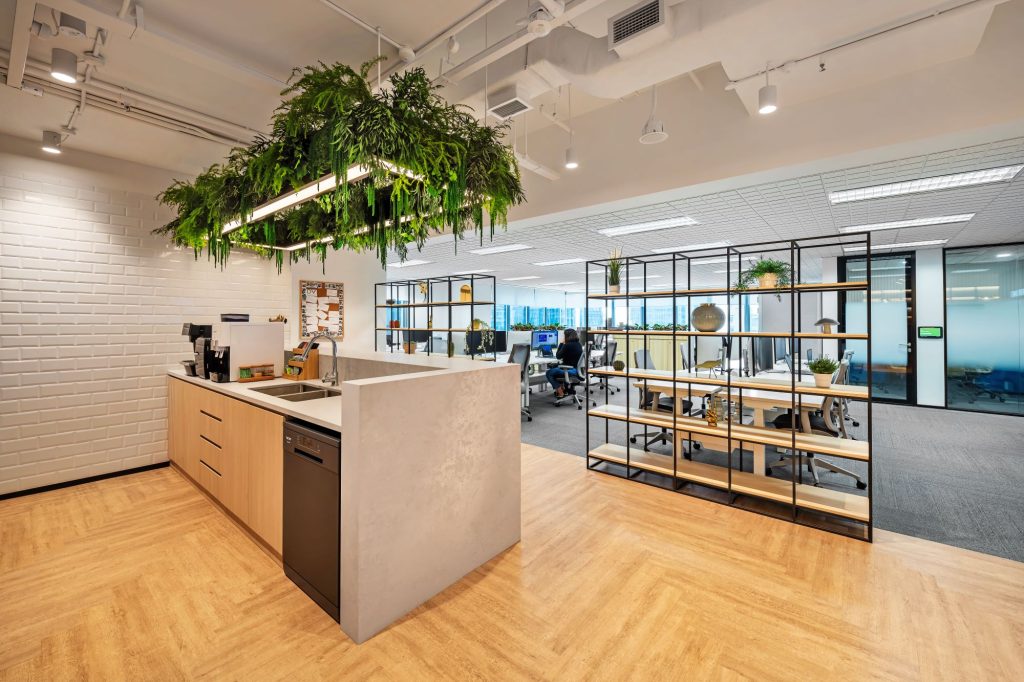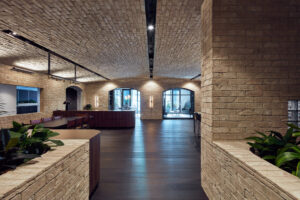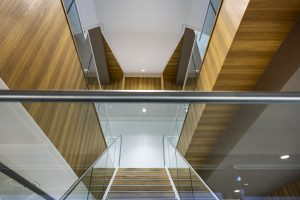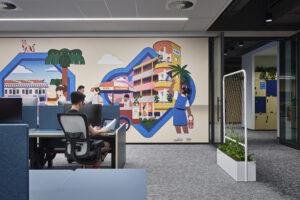Workplace Strategy 2025: Creating Environments That Drive Performance.

The evolution of workplace strategy has transcended traditional space planning to become a sophisticated discipline that integrates organizational psychology, performance metrics, and strategic business objectives. In 2025, successful companies recognize that effective office design and workspace design serve as powerful levers for driving productivity, innovation, and competitive advantage. This comprehensive analysis explores advanced workplace strategies that go beyond physical layout to encompass culture creation, data-driven optimization, and systematic change management approaches that deliver measurable business impact.
The Strategic Foundation of Modern Workplace Design
Workplace strategy in 2025 represents a fundamental shift from space allocation to experience orchestration. Organizations now understand that physical environments profoundly influence behavior, collaboration patterns, and ultimately business performance. This recognition has elevated workplace planning from facilities management to C-suite strategic priority, with companies investing significantly in environments that support their unique cultural values and operational objectives.
The integration of behavioral science and environmental psychology has created evidence-based approaches to office design that optimize human performance while supporting organizational goals. Research consistently demonstrates that well-designed workspaces can increase productivity by 25%, improve employee satisfaction by 40%, and reduce turnover costs by up to 30%.
Modern workplace strategy encompasses multiple disciplines: organizational development, technology integration, sustainability planning, and change management. This holistic approach ensures that physical environments align with business strategy while supporting the complex needs of diverse, multi-generational workforces.
Data-Driven Decision Making in Workplace Strategy
Contemporary workplace strategy relies heavily on workplace analytics and occupancy data to inform design decisions. Advanced sensor technologies provide real-time insights into space utilization, collaboration patterns, and environmental preferences, enabling evidence-based optimization rather than assumption-driven planning.
Post-occupancy evaluation has become a critical component of workplace strategy, with organizations tracking metrics such as employee engagement scores, collaboration frequency, innovation indices, and financial performance indicators to measure the effectiveness of their workplace investments.
Culture Integration Through Environmental Design
The most sophisticated workspace design strategies recognize that physical environments serve as powerful culture carriers, reinforcing organizational values and behavioral expectations through spatial design, material choices, and amenity programming.
Values-Based Design Principles
Organizations are increasingly using office design to communicate and reinforce their core values. Companies prioritizing innovation create environments with flexible, experimental spaces that encourage risk-taking and creative exploration. Organizations focused on collaboration design spaces that naturally bring people together while providing tools for effective teamwork.
Transparency as an organizational value manifests through glass-walled offices, open sight lines, and accessible leadership spaces. Sustainability commitments are demonstrated through material choices, energy systems, and waste reduction initiatives that employees can observe and participate in daily.
Behavioral Nudging Through Design
Sophisticated workplace strategy employs environmental psychology principles to influence desired behaviors through subtle design interventions. Strategic placement of collaboration zones, circulation patterns that encourage interaction, and visual cues that promote specific activities all contribute to shaping workplace culture.
The concept of “choice architecture” plays a crucial role in workplace design, with environments structured to make beneficial behaviors easier and more attractive. This might include positioning healthy food options prominently in cafeterias, creating inviting stairs to encourage physical activity, or designing quiet zones that naturally support focused work.
Performance Metrics and Measurement Frameworks
Advanced workplace strategy requires sophisticated measurement approaches that connect environmental interventions to business outcomes. Organizations are developing comprehensive frameworks that track both leading and lagging indicators of workplace effectiveness.
Productivity Metrics and Performance Indicators
Modern workplace measurement goes beyond traditional metrics like cost per square foot to encompass productivity indicators such as project completion rates, innovation output, and collaboration effectiveness. These metrics help organizations understand how their workspace investments translate into business value.
Advanced analytics platforms integrate multiple data sources to provide comprehensive performance dashboards. These systems track space utilization alongside business metrics, enabling organizations to identify correlations between environmental factors and performance outcomes.
Employee Experience and Satisfaction Metrics
Workspace design effectiveness is increasingly measured through employee experience indicators including satisfaction scores, engagement levels, and retention rates. Regular pulse surveys and feedback mechanisms provide ongoing insights into how workplace changes impact employee experience and productivity.
Net Promoter Scores (NPS) for workplace experience have become valuable indicators of space effectiveness, with high scores correlating strongly with overall employee satisfaction and business performance. These metrics help organizations understand which environmental features most significantly impact employee experience.
Innovation and Collaboration Measurement
Organizations are developing sophisticated methods for measuring innovation output and collaboration effectiveness in relation to their workplace strategies. This includes tracking patent applications, new product development cycles, cross-departmental project success rates, and knowledge sharing frequency.
Advanced workplace analytics can identify which spaces and environmental conditions correlate with the highest levels of creative output and successful collaboration, enabling organizations to optimize their environments for innovation.
Technology Integration and Smart Workplace Systems
The integration of advanced technology has become central to effective workplace strategy, creating intelligent environments that respond to user needs while providing valuable data for continuous optimization.
IoT and Environmental Optimization
Internet of Things sensors throughout workplace environments monitor air quality, lighting levels, temperature, humidity, and noise levels, automatically adjusting conditions to optimize comfort and productivity. These systems learn from usage patterns and user preferences to anticipate needs and reduce energy consumption.
Smart booking systems allow employees to reserve appropriate spaces for specific activities while providing utilization data that informs future space planning decisions. Integration with calendar systems and mobile applications creates seamless user experiences while generating valuable workplace analytics.
Artificial Intelligence and Predictive Analytics
AI-powered systems analyze workplace data to identify patterns and predict future needs, enabling proactive rather than reactive workplace management. These systems can forecast space demand, identify underutilized areas, and suggest optimal configurations for different types of work activities.
Machine learning algorithms continuously improve their recommendations by analyzing outcomes and user feedback, creating workplace environments that become more effective over time through continuous optimization.
Digital Workplace Integration
The physical and digital workplace have become increasingly integrated, with office design incorporating digital collaboration tools, interactive displays, and seamless technology connectivity throughout the environment. This integration supports hybrid work arrangements while ensuring that in-office experiences provide clear value over remote work options.
Advanced video conferencing capabilities integrated throughout office spaces support seamless collaboration with remote team members, while digital wayfinding and building information systems help employees navigate complex workplace environments efficiently.
Change Management and Workplace Transformation
Successful workplace strategy implementation requires sophisticated change management approaches that help employees adapt to new environments while maximizing the benefits of workplace investments.
Stakeholder Engagement and Communication
Effective workplace transformation involves extensive stakeholder engagement throughout the planning and implementation process. This includes employee surveys, focus groups, pilot programs, and continuous feedback mechanisms that ensure workplace changes align with actual user needs and preferences.
Communication strategies help employees understand the rationale behind workplace changes while providing training on new systems and protocols. Regular updates during implementation maintain engagement while addressing concerns and gathering feedback for continuous improvement.
Behavioral Change and Adoption Strategies
Workspace design success depends heavily on employee adoption of new behaviors and work patterns. Organizations employ various strategies to encourage adoption, including change champions, training programs, incentive systems, and gradual transition approaches that ease the shift to new work environments.
Pilot programs and phased rollouts allow organizations to test workplace concepts and refine their approaches before full implementation. These iterative approaches reduce risk while providing valuable learning opportunities that inform broader workplace strategies.
Cultural Adaptation and Evolution
Workplace transformations often require cultural adaptations that go beyond physical space changes. Organizations must consider how new environments might challenge existing cultural norms while working to align workplace design with desired cultural evolution.
Leadership modeling becomes crucial during workplace transitions, with executives demonstrating desired behaviors and utilization patterns. When leadership actively uses new spaces and follows new protocols, employee adoption typically increases significantly.
Flexibility and Future-Proofing Strategies
Modern workplace strategy must account for rapid changes in work patterns, technology capabilities, and organizational needs. Flexibility and adaptability have become essential characteristics of successful workplace designs.
Modular and Adaptable Design Solutions
Office design increasingly emphasizes modular systems and flexible infrastructure that can be reconfigured quickly and cost-effectively as needs change. This includes moveable walls, modular furniture systems, and flexible technology infrastructure that supports various space configurations.
Investment in building systems that can accommodate future technology requirements ensures that workplace investments remain relevant as technology evolves. This includes robust power and data infrastructure, flexible HVAC systems, and structural designs that support reconfiguration.
Scenario Planning and Contingency Design
Advanced workplace strategy incorporates scenario planning that considers various future possibilities and ensures that workspace investments can adapt to different potential outcomes. This includes designing for various occupancy levels, different work patterns, and evolving technology requirements.
Contingency planning addresses potential disruptions such as health crises, economic changes, or rapid organizational growth, ensuring that workplace strategies remain effective under various conditions.
Sustainability and Environmental Responsibility
Environmental sustainability has become a core component of modern workplace strategy, with organizations recognizing both the ethical imperative and business benefits of sustainable workplace design.
Circular Economy Principles
Workspace design increasingly incorporates circular economy principles that minimize waste and maximize resource efficiency. This includes selecting materials that can be recycled or repurposed, designing for disassembly and reconfiguration, and partnering with suppliers who support circular economy practices.
Life cycle assessments help organizations understand the full environmental impact of their workplace decisions, enabling more informed choices about materials, systems, and operational practices.
Energy Efficiency and Carbon Reduction
Advanced building systems optimize energy consumption through smart lighting, efficient HVAC systems, and renewable energy integration. These systems often provide significant cost savings while supporting corporate sustainability goals and regulatory compliance.
Carbon footprint measurement and reduction strategies help organizations track their environmental impact while identifying opportunities for improvement. Many companies are setting ambitious targets for carbon neutrality that directly influence their workplace strategies.
Health and Wellbeing Integration
Employee health and wellbeing have become central considerations in workplace strategy, with organizations recognizing the direct correlation between healthy environments and business performance.
Physical Health Support Systems
Modern office design incorporates features that actively support physical health, including ergonomic furniture systems, movement encouragement through active design, and fitness integration throughout the workplace. These features help prevent common workplace health issues while promoting overall wellbeing.
Air quality management systems exceed standard building codes to provide superior indoor environmental quality. Advanced filtration, monitoring, and ventilation systems create healthier environments that support respiratory health and cognitive performance.
Mental Health and Stress Reduction
Workspace design increasingly addresses mental health through stress reduction features such as quiet retreat spaces, biophilic design elements, and acoustic optimization. These features provide opportunities for mental restoration while supporting different personality types and work styles.
Mindfulness and meditation spaces have become common features in progressive workplace designs, providing dedicated areas for stress management and mental health support.
Global Considerations and Cultural Adaptation
As organizations operate increasingly globally, workplace strategy must consider cultural differences and local preferences while maintaining brand consistency and operational efficiency.
Cultural Sensitivity in Design
Different cultures have varying preferences for hierarchy expression, collaboration styles, and personal space requirements. Effective workspace design considers these cultural factors while creating inclusive environments that welcome diverse perspectives and work styles.
Local material sourcing and design traditions can create authentic connections with regional cultures while supporting sustainability goals and community relationships.
Regulatory Compliance and Standards
Global operations require navigation of varying building codes, accessibility requirements, and workplace regulations. Comprehensive workplace strategy ensures compliance while identifying opportunities to exceed minimum requirements for competitive advantage.
Future Trends and Emerging Directions
The evolution of workplace strategy continues accelerating, with emerging trends pointing toward even more sophisticated approaches to environment creation and optimization.
Personalization and Individual Adaptation
Future workplace technologies will enable unprecedented levels of personalization, with environments automatically adapting to individual preferences, work styles, and physiological needs. AI-powered systems will learn from individual behavior patterns to optimize environmental conditions for each user.
Regenerative Design Approaches
Beyond sustainability, regenerative design seeks to create workplaces that actively improve environmental and social conditions. This approach considers the positive impact that workplace environments can have on both occupants and surrounding communities.
Extended Reality Integration
Virtual and augmented reality technologies will create new possibilities for workplace experience, enabling immersive collaboration, enhanced visualization, and new forms of spatial interaction that transcend physical limitations.
Conclusion: Strategic Workplace Design for Competitive Advantage
The transformation of workplace strategy represents a fundamental shift toward environments that actively support business success through sophisticated integration of culture, technology, and human needs. Organizations that embrace comprehensive approaches to office design and workspace design create competitive advantages through improved productivity, enhanced innovation, and stronger talent attraction and retention.
Success in this evolving landscape requires understanding that workplace strategy is no longer a cost center but a strategic investment that directly impacts business performance. The integration of behavioral science, advanced technology, and systematic measurement creates workplace environments that evolve continuously to support organizational success.
The key lies in partnering with workplace strategy professionals who understand both the complexity of modern organizations and the sophisticated tools available for creating high-performance environments. As workplace design continues to evolve, this strategic approach will become increasingly essential for organizations seeking sustainable competitive advantage in knowledge-based economies.
Sources and References
This analysis draws from current research, industry studies, and workplace strategy reports from leading organizations and academic institutions:
Workplace Strategy Research
- Harvard Business School Workplace Studies
- MIT Center for Collective Intelligence Workplace Research
- Gensler Workplace Survey 2025
- CoreNet Global Corporate Real Estate Strategies
Performance and Productivity Studies
- McKinsey Global Institute Productivity Research
- Deloitte Future of Work Studies
- PwC Workforce of the Future Analysis
- Gallup State of the Global Workplace
Technology and Innovation Research
- International Data Corporation Future of Work Technology
- Accenture Future of Work Research
- Cisco Global Workforce Study
Sustainability and Wellbeing Sources
- World Green Building Council Health, Wellbeing & Productivity
- WELL Building Standard Performance Research
- LEED Green Building Research
- Center for Active Design Research
Research compiled and analyzed as of September 2025. Workplace strategies and organizational needs continue to evolve rapidly. For current strategic guidance and implementation assistance, consult with certified workplace strategy professionals who specialize in performance-driven environment design.



